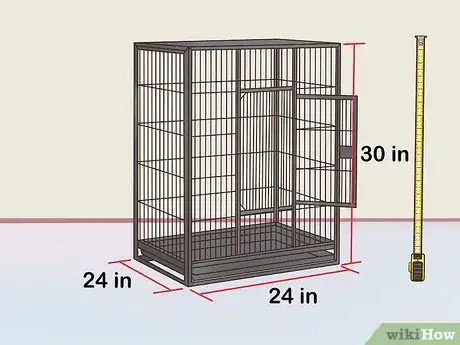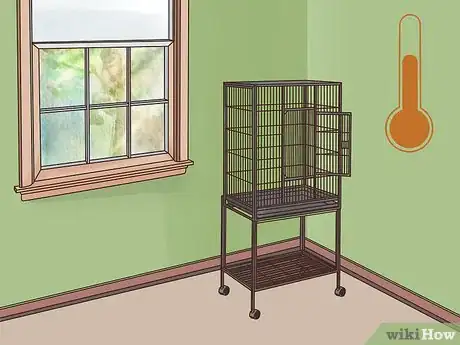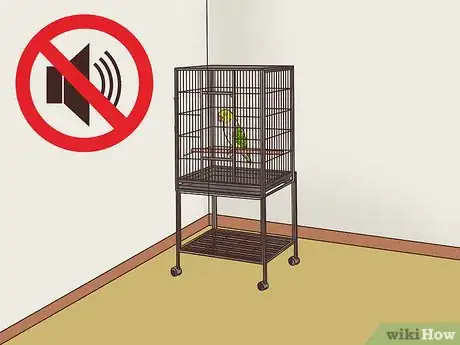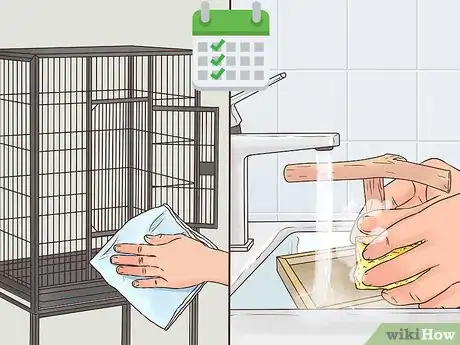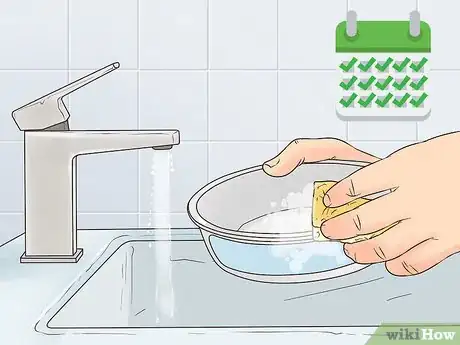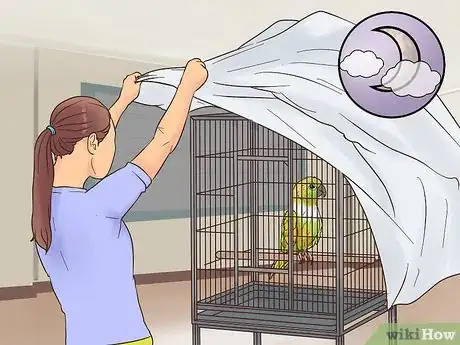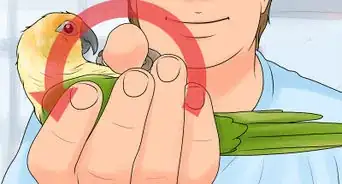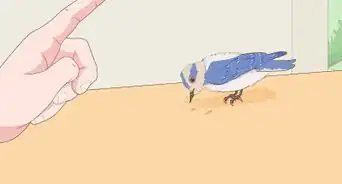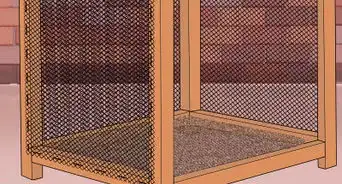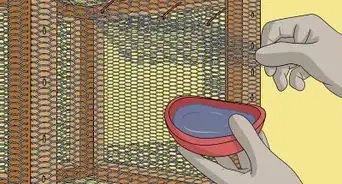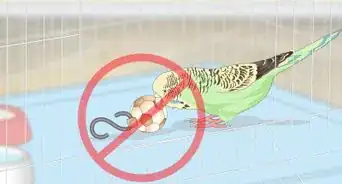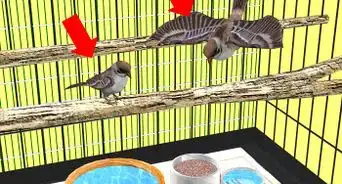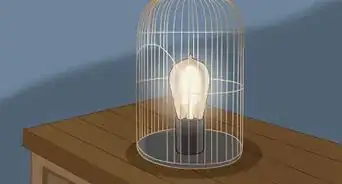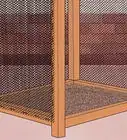This article was co-authored by Deanne Pawlisch, CVT, MA. Deanne Pawlisch is a Certified Veterinary Technician, who does corporate training for veterinary practices and has taught at the NAVTA-approved Veterinary Assistant Program at the Harper College in Illinois and in 2011 was elected to the board of the Veterinary Emergency and Critical Care Foundation. Deanne has been a Board Member of the Veterinary Emergency and Critical Care Foundation in San Antonio, Texas since 2011. She holds a BS in Anthropology from Loyola University and an MA in Anthropology from Northern Illinois University.
This article has been viewed 30,944 times.
Conures are members of the parrot family and often make great family pets due to their friendly, interactive nature. Conures need a large cage with plenty of space to move around in – both vertically and horizontally. They need several perches and a variety of toys to stay happy and engaged in their cage. Clean your conure’s cage diligently every week, and rinse out the food and water dishes daily.
Steps
Selecting the Cage and Its Contents
-
1Choose an appropriately sized cage. You want to give your conure the biggest cage possible so that it has a greater range of motion. As a minimum measurement, choose a cage that is 24 in (61 cm) wide by 24 in (61 cm) deep by 30 in (76 cm) high.[1]
- The cage bars should be spaced about 1⁄2 in (1.3 cm) to 3⁄4 in (1.9 cm) apart.
- At least two sides of the cage should have horizontal bars to encourage the bird’s climbing instincts.
-
2Insert perches for the bird. Include several perches of different widths and materials inside your conure’s cage. This will help your bird exercise its feet, move around the cage more freely, and even prevent arthritis. Provide a variety of lengths and sizes to keep your bird interested and engaged.[2]
- Each perch should be at least 9 in (23 cm) long and 1⁄2 in (1.3 cm) in diameter, for proper gripping.
- Place one perch up high for roosting, and at least one down low near the food and water dishes.
- You may also want to include some swinging perches to help your bird stay active and content.
Advertisement -
3Include a variety of toys. Toys will help keep your conure entertained and happy while it is home inside its cage. Provide a variety of toys for your bird so that it can choose different ones to play with at various times. Choose some foraging toys, puzzle toys, and ladders to keep the bird both physically and mentally active.[3]
- Try to also pick some shiny toys with bells or mirrors to entertain and engage the bird.
Positioning the Cage
-
1Place the cage somewhere off the ground. To do so, you can place the cage on a table, or on a bird cage stand. This will keep your conure’s cage closer to eye level and away from the ground. It will also help keep your bird’s cage away from heat vents or air conditioning pathways.[4]
- If the cage is located on the ground, it will be subject to possible drafts that could affect the health of the bird. It could also be more easily knocked over or moved around.
- Keep your conure’s cage out of doorways and other busy pathways that could potentially lead to the cage being knocked over.
- Try not to keep the cage above eye level. Doing so will encourage your bird to feel dominant, which could lead to behaviors like biting.
-
2Maintain an appropriate temperature. Conures can be kept at normal indoor room temperatures. The cage should be located in a room that is an average indoor temperature – not below 65 °F (18 °C) and never above 9 °F (−13 °C).[5]
- It’s important to keep them away from heating and cooling vents that could drastically change the temperature near their cage.
-
3Keep the cage in a quiet room. Conures require a quiet place to sleep at night. They can easily be kept up by loud noises and not get enough sleep, which can negatively impact the bird’s health.[6]
- If you must place the cage in a louder part of the house, consider getting a smaller cage for the bird to sleep in at night that you can move to a quieter location.
Caring for the Bird Cage
-
1Clean the cage and perches weekly. This includes removing all of the newspaper or other bedding at the bottom of the cage. It should be completely removed and replaced once per week. The perches should be removed and rinsed with a gentle soap and water, or washed in the dishwasher.[7]
- Wipe down the exterior of the cage once every week.
- Perform a more thorough disinfecting of the bird cage once every 6 months. Hose the entire cage down and replace any old perches or food dishes that are looking worn or dirty. Be sure to use a bird-safe disinfectant.
-
2Clean the food and water dishes daily. If not cared for properly, food dishes can become moldy and harmful for your conure, so it’s important to clean them out every day. This will help keep your bird safe and healthy.[8]
- Even just a quick rinse out in the sink is better than nothing. But try to use a gentle soap and warm water to clean them more thoroughly.
- Dry the dishes completely before placing them back inside the bird cage.
-
3Cover the cage at night. Use a large cotton cloth (probably a folded bedsheet) to cover your bird’s cage at night. Birds need a solid 10-12hours of uninterrupted sleep each night, and covering their cage helps them feel safe and sleep through the night.
- Do not cover the bird’s cage to avoid interacting with it or to fix behavioral problems – like screeching. This will only make the problems worse.
Warnings
- Conures can be very loud. They are not suggested for someone that needs quiet spaces, such as families with a newborn.⧼thumbs_response⧽
References
- ↑ https://www.petco.com/content/petco/PetcoStore/en_US/pet-services/resource-center/caresheets/green-cheek-conure.html
- ↑ http://www.peteducation.com/article.cfm?c=15+1794&aid=2648
- ↑ http://greencheekconure.net/2013/03/green-cheek-conure-and-parrot-toy-guide.html
- ↑ https://www.thatpetplace.com/articles/sun-conures-article
- ↑ https://www.petco.com/content/petco/PetcoStore/en_US/pet-services/resource-center/caresheets/green-cheek-conure.html
- ↑ https://www.thatpetplace.com/articles/sun-conures-article
- ↑ http://animal-world.com/encyclo/birds/conures/ConuresProfile.htm
- ↑ http://www.peteducation.com/article.cfm?c=15+1794&aid=2837
About This Article
To house a conure, choose a cage that’s at least 24 inches wide, 24 inches deep, and 30 inches high to give it enough room. You should also make sure the cage bars are spaced between ½ inch and ¾ inch apart so it can’t escape. Once you have a cage, put a variety of perches in it to allow your bird to move around easily. If your bird is especially active you might consider giving it a swinging perch as well. Besides perches you should give it a variety of toys like ladders, bells, and puzzle toys, so it doesn’t get bored. Once your cage is set up, make sure to place it in a quiet room, since conures need a quiet place to sleep at night. To learn how to care for your new conure, read more from our Veterinary co-author!
